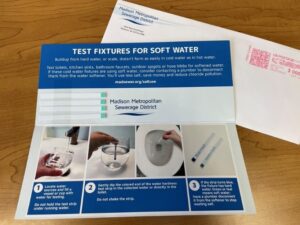Welcome to #HardWaterHacks … where we debunk myths and provide practical tips for living with water that’s less softened or using softening alternatives to reduce chloride pollution. Each topic in the series, like this article on toilets, has been researched through the personal experiences of District pollution prevention specialist Catherine Harris as she embraces our naturally mineral-rich area groundwater, works to change social norms on home salt use and reduces chloride pollution in natural systems.
Tips by Catherine Harris
Our first few blogs in the #HardWaterHacks series have focused on water that usually isn’t (or shouldn’t be) softened — like water from the kitchen faucet or outside hose bibb/spigot. Today, we turn to another area of the home where, similarly, soft water is not always necessary: the toilet.
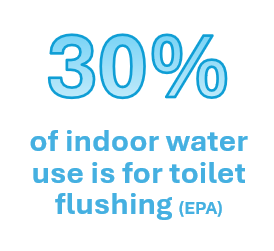
Toilets are important
Toilets are a part of everyday life. According to the EPA, an average person flushes a toilet about 140,00 times over the course of a lifetime! EPA also estimates that toilets comprise about 30% of overall indoor water use. Flushing is one of the areas of your home that uses the most water, so toilet improvements (either with salt reduction or water conservation) can make a big impact.
Are you connected?
Believe it or not, toilets aren’t always connected to a water softener. For the environment and your local wastewater treatment plant, that’s a good thing. Many homes manage just fine without softened water running to a toilet – including mine!
Across our service area, toilet-softener connections can vary widely. According to recent data from a paired sewershed study and the Salt Savers pilot program:
- On Madison’s near west side, only 15% of homes had toilets connected to softeners.
- In the Town of Dunn, it was much higher – about 95%.
- In McFarland, it fell somewhere in-between at 65%.
To find out if your toilet water is softened, you can use water hardness test strips, conduct a soap test with something pure like Dr. Bronner’s or ask your plumber. Watch this instructional video for helpful water testing how-tos.
Consider disconnecting
If your toilet is connected to a softener, nearly one-third of your home’s water is unnecessarily softened. That’s a large portion of your monthly salt use and investment that could be avoided! Reducing salt is a win for the environment AND your budget.
Check for leaks!
Toilet leaks are sneaky but common. And leaks are easy to check for. Here’s a simple leak test from Madison Water Utility.
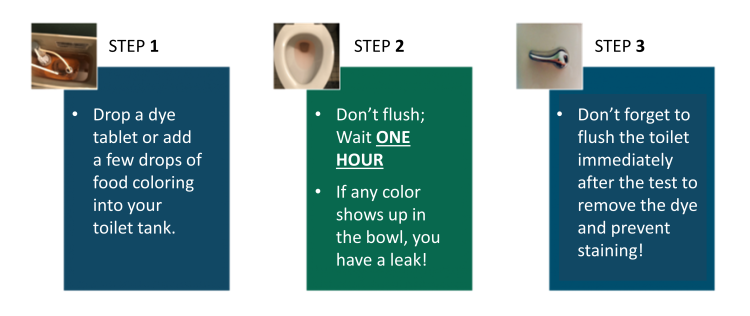
I tested my own three toilets while writing this blog. Oops – I discovered a leak in one toilet and will need to replace a flapper soon! But, by other two toilets (both unsoftened for seven years) passed the test just fine. They had no damage from hard water and no excessive build-up. Phew!
Toilet #HardWaterHacks
The Ring
Let’s talk about THE notorious issue people associate with hard water toilets: the toilet bowl ring. The ring can appear in any toilet, but hard water minerals can make it harder to remove. In my experience, regular toilet cleaning with a brush and standard cleaning products has been enough. I’ve never personally had a persistent ring issue, even with hard water.
Water quality and composition vary from place to place, though, so what happens if you do have a “ring”? The plumber’s secret weapon is surprisingly simple: a pumice stone. (Yes, the same thing you might use for your feet!) Check out some of the many how-to videos online by searching “hard water pumice stone” — or start here.
Best cleaners
Working at the wastewater treatment plant, I get this question a lot: Is it ok to use toilet bowl cleaner?
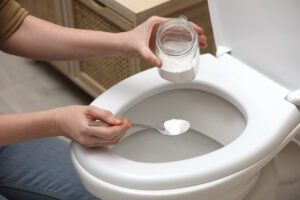
The answer from our operations staff is that liquid toilet bowl cleaners in small quantities are fine. However, don’t use the whole bottle and definitely don’t use more than one type of cleaner at a time! Not only is using large quantities of cleaners bad for the treatment plant and private septic systems, but mixing the wrong chemicals together can create dangerous gases that are really bad for your health. Really, it’s the abrasive action of scrubbing and using a little elbow grease that brings the most benefit.
You can also try a powdered cleaner. Bon Ami powdered cleaner has natural soft abrasives (feldspar and limestone) that are scratch-free and has no harsh chemicals. Or, Bar Keeper’s Friend powdered cleaner contains oxalic acid and works well for any hard water buildup. However, BKF is not great for plastic toilets or lids.
New tech for prevention
Interestingly, newer toilets might have some features that could help eliminate issues that might arise due to scale. If you’re upgrading your toilet, consider models with coated bowls designed to reduce sticking and buildup or flapperless flush systems. Another emerging tool is Krazy Kleen, a magnetic device that sits in the tank and claims to prevent scale buildup. A few District staff are currently testing it in their homes. I haven’t found conclusive test data comparing toilet models specifically for hard water performance… yet. But I’m still looking.
Back of the tank bonus
Thanks to social media videos and forums, cleaning the back of your toilet tank with citric acid is trending. You can generally find citric acid at the grocery store since it’s used for canning. The quantity you’d be using for this type of cleaning isn’t enough or at a strength that would impact the wastewater treatment plant.
I tried it myself. It made the tank a bit cleaner, though I’ll admit my toilet is pretty old and I don’t check back there often. Still, it’s a good option if you’re feeling ambitious or just love a sparkling clean toilet tank.
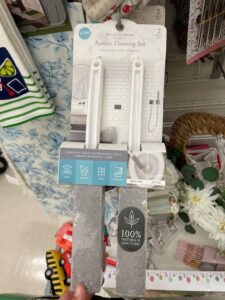
Key takeaways
- Test your toilet. It might be connected to a softener, and it might not need to be.
- Cleaning frequency varies. You may not need to clean more often with hard water – your mileage may vary!
- Fix leaks to conserve water. Even small ones can add up fast.
- Scour (naturally!) For tough stains or mineral rings, try a pumice stone. Be sure use it carefully and correctly.
- Try new tech. Keep an eye out for new technologies and inventions that might make maintenance easier over time.
Hard water doesn’t have to be hard to live with — especially if it helps us use less salt and protect our local lakes and streams. Thanks for following along with #HardWaterHacks. Stay tuned for more myth-busting and salt-saving tips in future posts!






